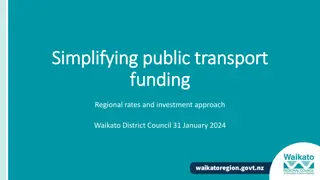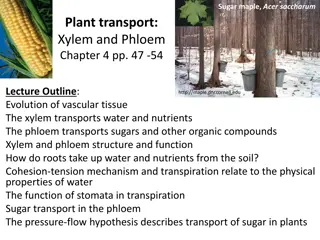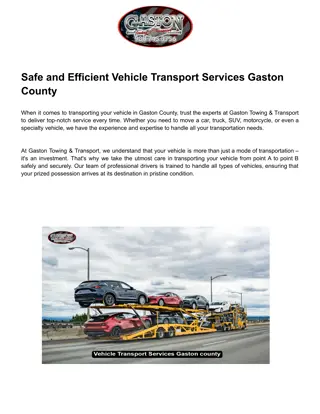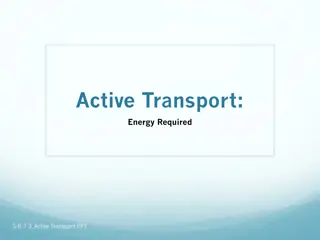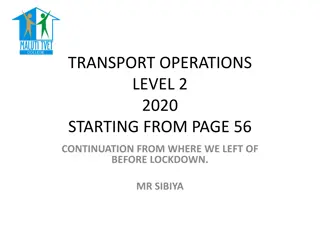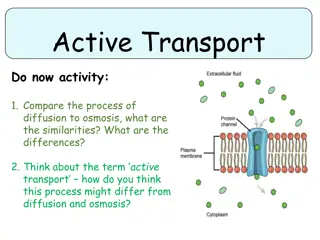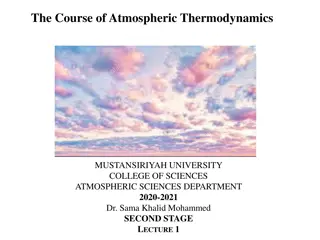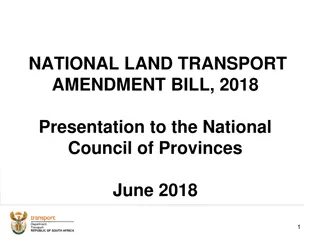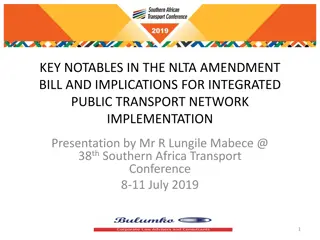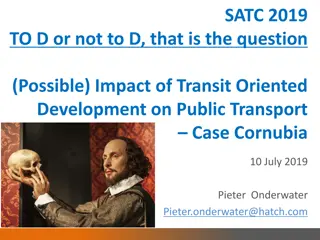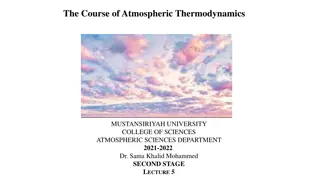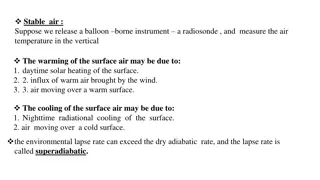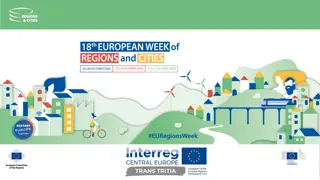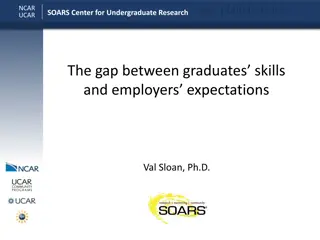Streamlining Public Transport Funding in Waikato District Council
Simplifying and streamlining the public transport funding approach in Waikato District Council to enhance integration, flexibility, and decision-making, while reducing financial risks. The objective is to make it easier to implement the Regional Public Transport Plan and improve the overall transpor
1 views • 35 slides
Climate Action Strategy for Decarbonising Inland Transport by 2050
The Inland Transport Committee (ITC) has adopted a strategy to reduce greenhouse gas emissions from inland transport, aligning with the goal of achieving net-zero emissions by 2050. This strategy includes a focus on reducing GHG emissions, setting strategic objectives, implementing climate actions,
1 views • 19 slides
Understanding Plant Transport Systems: Xylem and Phloem
Explore the intricate system of plant transport through xylem and phloem, from how roots absorb water to the pressure-flow hypothesis in sugar transport. Learn about the evolution, structure, and function of vascular tissues and the critical role of transpiration. Dive into the classification of pla
3 views • 27 slides
The Perfect Relocation: Know the Affordability of Bike Transport by Train Parcel
Concerned about your limited budget but still want to transport your bike to another city or location? The train can be your choice. How? You will figure it out once you read this blog till the end. We have mentioned a few critical reasons emphasizing the affordability of the\u00a0bike transport by
3 views • 2 slides
Safe and Efficient Vehicle Transport Services Gaston County
\nFor safe and efficient Vehicle Transport Services Gaston County, look no further! Our expert team ensures your vehicle arrives at its destination securely and on time. Whether you need local or long-distance transportation, we prioritize safety and reliability. Trust us to handle your vehicle with
23 views • 3 slides
Challenges and Solutions in Rail-Road Competition and Co-ordination
Rail and road transport in India are experiencing a competitive landscape, with road transport gaining prominence over railways. This shift poses challenges such as operational costs, efficiency issues, and the need for better co-ordination between the two modes of transport. To address these challe
0 views • 5 slides
Understanding Atmosphere Composition and Structure in Climatology
The study of climatology, focusing on the atmosphere, is presented by Dr. Banashree Saikia, covering topics such as atmospheric composition, insolation, temperature variations, atmospheric pressure, wind systems, atmospheric moisture, climatic classification, cyclones, and monsoons. The atmosphere,
1 views • 9 slides
Understanding Active Transport: Energy-Driven Cellular Processes
Active transport is a vital process in cells that require energy in the form of ATP to move materials across the plasma membrane against their concentration gradient. This process involves pumps, endocytosis, and exocytosis. The sodium-potassium pump in nerve cells is a classic example of active tra
0 views • 9 slides
Understanding Transport Operations: Modes, Categories, and Efficiency
Explore typical transport operations across various modes, including land, water, and air transportation. Learn about the advantages and disadvantages of different modes, such as road, railway, and air transport. Delve into scheduling long-distance trips and the impact of guidelines on transport eff
1 views • 9 slides
Understanding Cell Membrane Transport: Diffusion and Facilitated Diffusion
Cell membrane transport plays a crucial role in maintaining cellular functions by regulating the movement of substances across the membrane. Diffusion, a passive transport process, allows molecules to move from areas of high concentration to low concentration without energy expenditure. Within diffu
1 views • 20 slides
Understanding Passive and Active Transport in Cells
Explore the processes of diffusion, osmosis, and active transport in cells. Understand the similarities and differences between them, and learn why active transport is crucial for living organisms. Watch a video on active transport and answer related questions to deepen your knowledge. Enhance your
1 views • 12 slides
Advancing Low Carbon Development in Sustainable Transport
Thierry Nervale, Deputy Director of the Transport SPC EDD Programme, highlights the importance of sustainable transport in achieving economic growth, social equity, and environmental preservation. The UN Conference on Sustainable Development underscores the central role of transportation in sustaina
4 views • 17 slides
Understanding Geopotential and Geopotential Height in Atmospheric Thermodynamics
Explore the concept of geopotential and geopotential height in atmospheric sciences, focusing on their significance in understanding gravitational and centrifugal forces on Earth. Learn about the definition, calculation, and applications of geopotential height in relation to atmospheric properties a
1 views • 14 slides
Understanding Atmospheric Moisture in Physical Geography
Atmospheric moisture, in the form of water vapor, liquid water, and ice, plays a crucial role in shaping weather and climate. This course delves into the dynamics of atmospheric moisture, including its distribution, effects on weather patterns, and impact on various climatic factors such as precipit
0 views • 7 slides
Understanding Atmospheric Thickness and Its Applications
Atmospheric thickness refers to the difference in geopotential height between two pressure surfaces, which is dependent on the mean virtual temperature of the layer in between. This concept plays a key role in determining temperature gradients, identifying fronts, and aiding in weather forecasting,
0 views • 11 slides
HyTrEc2: Advancing Hydrogen Transport Economy in the North Sea Region
HyTrEc2, a project under the Interreg VB North Sea Programme, aims to promote green transport and mobility by implementing innovative hydrogen transportation solutions. With a vision to stimulate hydrogen-fueled transport for a sustainable future, the project focuses on developing zero-emission solu
0 views • 23 slides
Understanding Synoptic Meteorology: A Comprehensive Overview
Synoptic meteorology delves into various aspects of atmospheric sciences, encompassing scales of atmospheric motion, weather maps, air masses, fronts, jet streams, and more. Through the study of synoptic meteorology, meteorologists gain insights into interpreting the state of the troposphere and for
1 views • 17 slides
National Land Transport Amendment Bill 2018 Overview
The National Land Transport Amendment Bill of 2018 aims to address developments in the land transport system since 2009. It includes provisions for non-motorised and accessible transport, revises public transport contracting arrangements, clarifies government functions, streamlines operating license
0 views • 44 slides
Understanding Atmospheric Pressure Variations at Different Altitudes
Atmospheric pressure varies with altitude due to the weight of the air column above. This activity explores how Otto von Guericke's experiments with vacuum systems demonstrate the power of air pressure. Theoretical concepts of atmospheric pressure are discussed, highlighting its relation to gravity
0 views • 28 slides
Cutting-Edge Atmospheric Chemistry Modeling Research at Barcelona Supercomputing Center
Conducted by the Atmospheric Composition Group at Barcelona Supercomputing Center, this cutting-edge research focuses on atmospheric chemistry modeling using advanced tools and frameworks like HERMESv3 and MONARCH. The team's approach integrates various modules to study complex processes influencing
0 views • 16 slides
Understanding Fluid Statics and Atmospheric Pressure Measurements
Exploring the concept of fluid statics, this content delves into topics such as how atmospheric pressure is measured, buoyancy, and why a steel boat can float. It covers the measurement of pressure, the relationship between pressure and depth in fluids, and demonstrations showcasing these principles
0 views • 24 slides
Key Notables in NLTA Amendment Bill for Integrated Transport Network
Presentation by Mr. R. Lungile Mabece at the 38th Southern Africa Transport Conference focusing on notable changes in the National Land Transport Act (NLTA) Amendment Bill and implications for implementing an Integrated Public Transport Network (IPTN). The presentation discusses key developments, im
0 views • 16 slides
Overview of Low-Cost Sensors for Atmospheric Composition Measurement
This publication provides an insightful overview of low-cost sensors for measuring atmospheric composition, covering topics like sensor technologies, applications in atmospheric sciences and air quality management, and evaluation methods. It emphasizes the importance of not only the technical perfor
0 views • 17 slides
Understanding Atmospheric Circulation on Earth
An atmospheric circulation driven by temperature differences between the equator and poles influences global weather patterns. The sun's changing angle throughout the year results in various pressure areas and the formation of large circulation cells. The main effects include the transport of humidi
0 views • 11 slides
Understanding Transport Timescales and Source Regions of UTLS Air
Complex mixtures of air in the Upper Troposphere and Lower Stratosphere (UTLS) are studied using in situ trace gas measurements from the START08 campaign and surface stations. This research aims to determine transport timescales and source regions of air in the extratropical UTLS, focusing on high a
0 views • 11 slides
Comprehensive Overview of Transport Operations
Explore the various aspects of transport management including mechanisms for ensuring a smooth flow of goods, freight characteristics, criteria for selecting vehicles, lorry fleet management, ground transport capacities, and factors influencing transport decisions. Learn about managing lorry fleets,
0 views • 10 slides
Uganda Transport Sector Development Partners Group Priorities FY 19/20
This document outlines key priorities identified by the Uganda Transport Sector Development Partners Group for the fiscal year 2019/2020. The priorities include institutional framework optimization, legislative reforms, preparation of policy reports, and capacity-building initiatives within the tran
0 views • 6 slides
Understanding the Planetary Boundary Layer in Atmospheric Science
The Planetary Boundary Layer (PBL) plays a crucial role in atmospheric dynamics, divided into surface, mixed, stable, and residual layers. During the day, the mixed layer experiences convective motions due to surface heating, while the stable layer dominates during the night. Understanding these lay
0 views • 18 slides
Impact of Transit Oriented Development on Public Transport: Case Cornubia
Investigate the influence of Transit Oriented Development (TOD) factors on the public transport system, including improved public transport density, mixed-use design, and pedestrian-friendly infrastructure. This paper explores the theoretical application of TOD in urban planning with a focus on the
0 views • 16 slides
NSF Atmospheric Chemistry Program Overview
The NSF Atmospheric Chemistry Program aims to characterize the chemical composition of the atmosphere, understand chemical processes, quantify fluxes of chemical substances, study natural and anthropogenic causes of variability, and assess impacts on climate. The program supports research through pe
0 views • 6 slides
Understanding Atmospheric Chemistry Measurements and Methods
Explore the various types of atmospheric chemistry measurements, including research vs. monitoring, gas phase species, satellite vs. in situ observations, and spectroscopy and chromatography methods. Discover how researchers and regulatory bodies use different techniques to study and monitor air qua
0 views • 34 slides
Understanding Atmospheric Composition and Structure
The presentation covers fundamental concepts related to the Earth's atmosphere, including its composition, origin of oxygen, dry and moist layers, standard atmosphere layers, and temperature variations. Key topics discussed include the primordial atmosphere, atmospheric constituents, water vapor dis
0 views • 58 slides
Understanding Atmospheric Thermodynamics and Environmental Lapse Rate
Explore the concepts of atmospheric thermodynamics including the Parcel Method, Environmental Lapse Rate, and Conditionally Unstable Atmosphere. Dive into the details of how air parcels behave in different atmospheric conditions and understand the significance of temperature changes in the atmospher
0 views • 27 slides
GEOS-Chem Atmospheric Chemistry Model Overview
GEOS-Chem, developed by Daniel J. Jacob at Harvard University, is a global model of atmospheric composition used to understand human and natural influences on the environment. The model addresses various atmospheric chemistry issues on different scales, from local to global, and is regularly updated
0 views • 19 slides
Understanding Atmospheric Stability and Adiabatic Processes
Atmospheric stability is crucial in determining weather conditions. Different processes such as adiabatic cooling play a significant role in the vertical movement of air masses. Understanding the environmental lapse rate, moist and dry adiabatic rates, and the concept of conditional instability help
0 views • 4 slides
Understanding Atmospheric Pressure, Wind Variations, and Humidity in Weather Systems
The atmosphere is composed of various elements like gaseous molecules, water vapor, and dust particles. Key weather variables include atmospheric pressure, temperature, humidity, wind, cloud cover, and precipitation. Atmospheric pressure is influenced by the weight of air above a point, with average
0 views • 17 slides
Enhancing Freight Transport Coordination in Trans Tritia Project Territory
Improving freight transport coordination and planning in the Trans Tritia project territory covering Poland, Czech Republic, Slovakia, and specific regions aims to address territorial challenges, enhance regional integration, and foster cross-border cooperation. The project, co-financed by the Europ
0 views • 15 slides
The DC and AC global atmospheric electric circuits as central tenets in Earth system science today
The presentation at the EGU General Assembly highlighted the significance of DC and AC global atmospheric electric circuits in Earth system science. Key references from 2007 to 2018 underscore the evolving research in this field, exploring the interconnectedness between the space environment and the
0 views • 23 slides
Addressing the Gap Between Graduates' Skills and Employers' Expectations in Atmospheric Geosciences
The article discusses the skills gap in the atmospheric geosciences field, highlighting key technical and communication skills needed by graduates and postgrads. It explores strategies to bridge this gap through surveys, creative solutions, and innovative approaches like updating degree requirements
0 views • 5 slides
Analysis of Atmospheric Parameters and Transmission at OHP in 2018
This analysis focuses on the atmospheric parameters and transmission at the Observatoire de Haute-Provence (OHP) during 2018, with a specific emphasis on distinguishing between typical winter and summer conditions. The study utilizes MERRA2 data from January to August to examine pressure, precipitab
0 views • 16 slides
